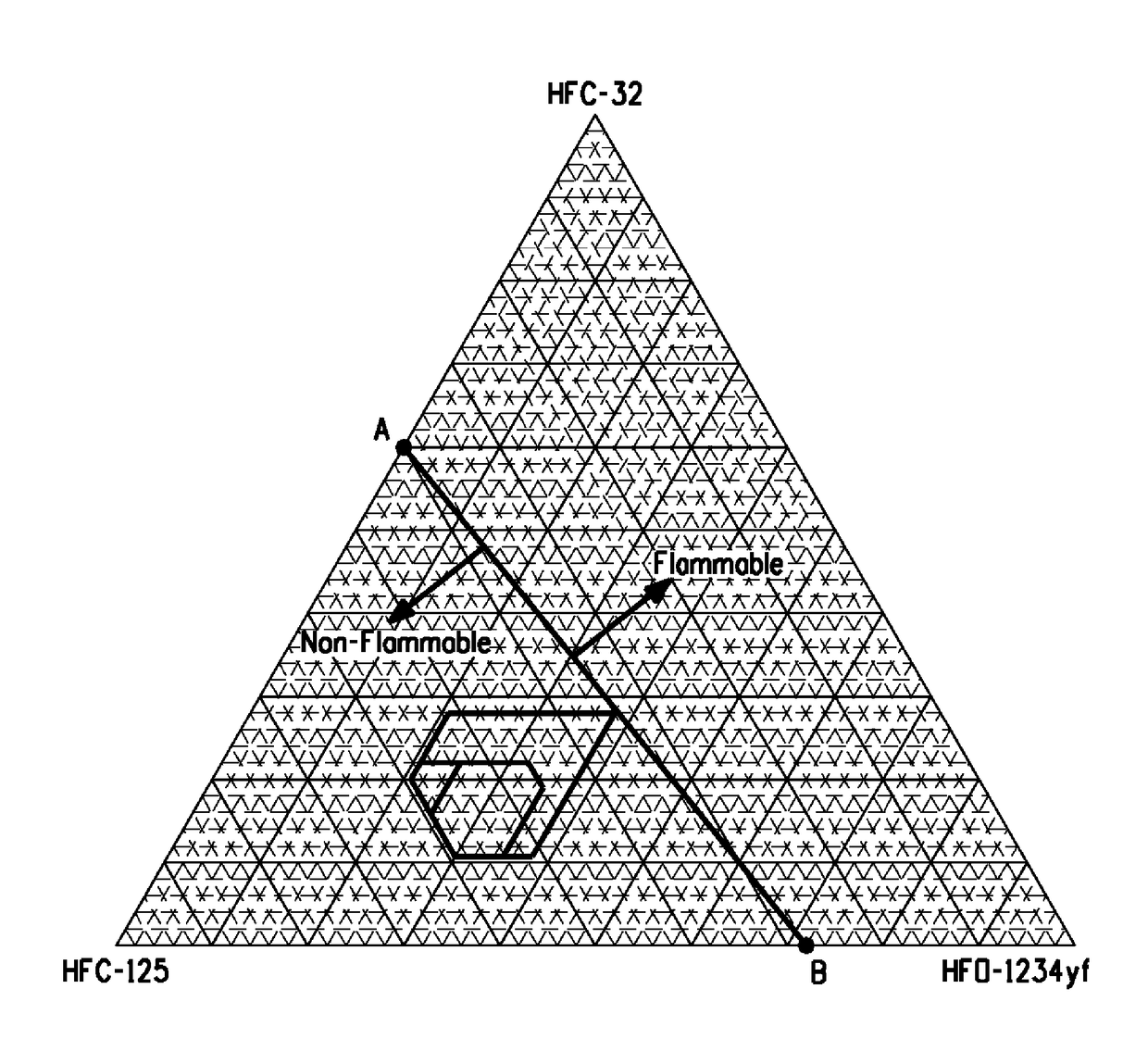Refrigerant mixtures comprising difluoromethane, pentafluoroethane, and tetrafluoropropene and uses thereof
a technology of difluoromethane and pentafluoroethane, which is applied in the direction of refrigerating machines, lighting and heating apparatuses, chemistry apparatuses and processes, etc., can solve the problems of early breakdown of compressors, and achieve the effect of high compressor discharge temperature, low gwp and high gwp
- Summary
- Abstract
- Description
- Claims
- Application Information
AI Technical Summary
Benefits of technology
Problems solved by technology
Method used
Image
Examples
example 1
Cooling Performance
[0117]Cooling performance at low temperature refrigeration conditions for compositions of the present invention is determined and displayed in Tables 1a and 1b as compared to R-404A, R-407A, R-407F, and R-507A. Compressor discharge temperatures, COP (energy efficiency) and cooling capacity (cap) are calculated from physical property measurements for the following specific conditions:
[0118]
Evaporator temperature−35° C.Condenser temperature 40° C.Subcool amount6KReturn gas superheat−15° C.Compressor efficiency70%
[0119]GWP has also been calculated based on IPCC AR4 values where available.
[0120]
TABLE 1aAvgDischSuctRel SuctDischFlammableGWPGlide,TPP vs 404APRel Dischor non-Compositions(AR4)K(° C.)(kPa)(%)(kPa)P vs 404AflammableR-404A39220.4901671001833100non-flamR-50739850.02881741041880103non-flamR-407A (20 / 40 / 4021074.311213279171794non-flamwt %) 32 / 125 / 134aR-407F (30 / 30 / 40)18253.9120153921905104non-flam32 / 125 / 134aCompositions, 32 / 125 / 1234yf, wt %11 / 59 / 3021402.9921559...
example 2
Cooling Performance
[0123]Cooling performance at medium temperature refrigeration conditions for high ambient temperatures for compositions of the present invention is determined and displayed in Tables 2a and 2b as compared to R-22. Compressor discharge temperatures, COP (energy efficiency) and cooling capacity (cap) are calculated from physical property measurements for the following specific conditions:
[0124]
Evaporator temperature−10° C. Condenser temperature40° C.Subcool amount6KReturn gas superheat 0° C.Compressor efficiency70%
[0125]GWP has also been calculated based on IPCC AR4 values where available.
[0126]
TABLE 2aAvgDischSuctRel SuctDischRel DischFlammableGWPGlide,TPP vs 404APP vs 404A,or non-Composition(AR4)K(° C.)(kPa)(%)(kPa)%flammableR404A39220.4664361001833100non-flamR407A (20 / 40 / 4021074.47937386171794non-flamwt %) 32 / 125 / 134aR407F (30 / 30 / 40)18254.68539290179798non-flam32 / 125 / 134aCompositions, 32 / 125 / 1234yf, wt %11 / 59 / 3021403.16841796180799non-flam22 / 57 / 2121442.3744781102...
example 3
Flame Boundaries for Compositions
[0129]The flammability limits were determined for binary compositions of HFC-32 and HFC-125 and also HFC-125 and HFO-1234yf. The measurements were made following the procedures described in a standard method of the American Society of Testing and Materials (ASTM). ASTM-E681-04 was used for these measurements done at 60° C. and 50% relative humidity. Results are shown in Table 3.
[0130]
TABLE 3Flammable orPoints on FIG. 1CompositionNon-flammableTriangle DiagramHFC-32 / HFC-125,Non-flammableA60 / 40 wt %HFO-1234yf / HFC-125,Non-flammableB72 / 28 wt %
[0131]Data points A and B are the compositions with the highest level of the flammable component (either HFC-32 or HFO-1234yf) that was found to be non-flammable. Therefore, those compositions containing HFC-32 and HFC-125 with higher than 60 wt % HFC-32, will be flammable. Likewise, those compositions containing HFO-1234yf and HFC-125 with higher than 72 wt % HFO-1234yf will be flammable. With reference to FIG. 1, w...
PUM
| Property | Measurement | Unit |
|---|---|---|
| weight percent | aaaaa | aaaaa |
| weight percent | aaaaa | aaaaa |
| temperature | aaaaa | aaaaa |
Abstract
Description
Claims
Application Information
 Login to View More
Login to View More - R&D
- Intellectual Property
- Life Sciences
- Materials
- Tech Scout
- Unparalleled Data Quality
- Higher Quality Content
- 60% Fewer Hallucinations
Browse by: Latest US Patents, China's latest patents, Technical Efficacy Thesaurus, Application Domain, Technology Topic, Popular Technical Reports.
© 2025 PatSnap. All rights reserved.Legal|Privacy policy|Modern Slavery Act Transparency Statement|Sitemap|About US| Contact US: help@patsnap.com

